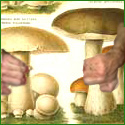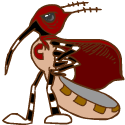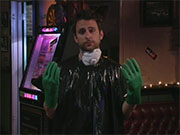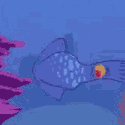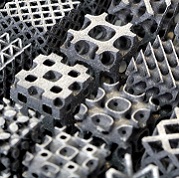I've been meaning to make a thread about this for a while. Carnivorous plants are cool as gently caress. 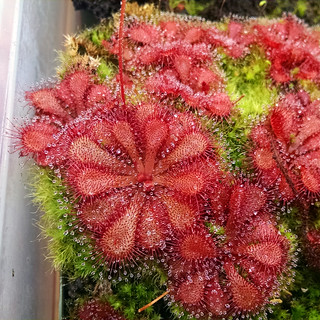 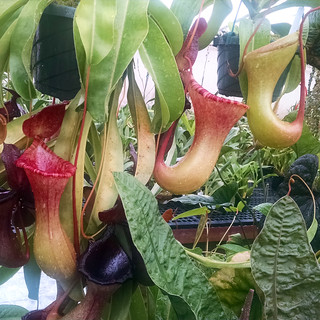 About carnivorous plants: Carnivorous plants are, by a broad definition, any plants which gain some or all of their nutrients from prey they trap using specialized trapping structures. Some plants eat poop instead. Some eat other plants. Some have really complicated relationships with bugs to make this all work. They're all cool as gently caress, and fun to grow and collect. About me: I've been growing carnivorous plants for a little over two years. My favorite are sundews, from genus Drosera, but I grow all sorts. I have a blog about my collection, and am vice president of my local carnivorous plant society. I was mostly kidding about the "profit" part. I do sell seeds and plants to other hobbyists though I'm aiming to break even on my hobby sometime in the next year. I've also started working at a carnivorous plant nursery recently, which means I basically think about plants all the time. Cultivating carnivorous plants: Most carnivorous plants are fairly simple to grow once you get their basic requirements met. They might need a bit more initial setup than, say, lucky bamboo (Dracaena sp.), but once you get them set they can be very low-maintenance. Most carnivores need 3 things to live: Bright light Nutrient-poor soil Low-mineral water (lots) For the light, full sun outside is good, as is (bright) fluorescent light indoors. Very bright windowsills work for some genera. For the soil, a mixture of Sphagnum peat and coarse sand is standard for lots of species, and the rest like pure long-fiber Sphagnum (also known as orchid moss). For the water, distilled, RO, or rain water is preferred, although some people are blessed with tap water below 50 TDS (total dissolved solids), which is fine. The bog-dwelling genera (Drosera, Pinguicula, Sarracenia, Dionaea, most Utricularia) can sit directly in a tray of water to keep wet, while others (Nepenthes primarily, but also Heliamphora and the carnivorous bromeliads) like to be watered weekly or so. Feel free to ask me any sort of question about carnivorous planst! If I don't know the answer I probably know who to ask to get the answer. I can also help you get started if you're interested in getting a plant or two to try it out. I'll also post about the various genera in upcoming posts. 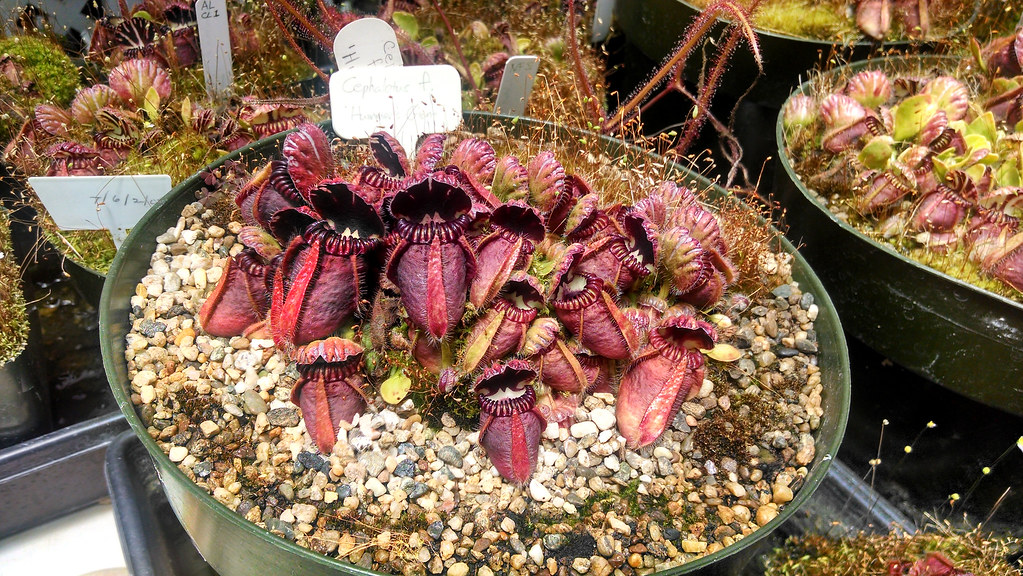
Kenning fucked around with this message at 18:15 on Feb 15, 2016 |
|
|
|
|

|
| # ? Apr 26, 2024 13:12 |
|
Can they eat steak???
|
|
|
|
So, I've always liked the pitchers and fly traps, but how much bug do they need to eat? I have almost no obvious bugs in my home, so how would I feed them? I know the 'cooked hamburger' is supposedly bad, and I can't imagine nitrogen spikes are enough. (Sorry, I know almost nothing about plants.)
|
|
|
|
Are the plants expensive?
|
|
|
|
We have a venus fly trap that we bought probably two weeks ago. It looks healthy and green and has half a dozen fully developed trap thingies. Despite this, and the fact that we're in a record summer with an infuriating number of flies everywhere, it has yet to catch a single one. Is this normal?
|
|
|
|
|
 where can I get one of these?
|
|
|
Anderron Shi posted:Can they eat steak??? If you feed a big, very healthy plant an extremely small piece of steak it should be fine. However, the carnivorous adaptations are specialized towards digesting bug material, rather than mammal muscles, so the steak will probably end up leading to the trap that you feed it to rotting (the plant will likely survive). I feed my sundews ground-up betta fish food, since it's made of krill and krill are the bugs of the sea. Culex posted:So, I've always liked the pitchers and fly traps, but how much bug do they need to eat? I have almost no obvious bugs in my home, so how would I feed them? I know the 'cooked hamburger' is supposedly bad, and I can't imagine nitrogen spikes are enough. (Sorry, I know almost nothing about plants.) They don't need that many bugs really. Like most plants, carnivores mainly need light and water to live. The bugs are basically fertilizer. Most carnivorous plants can live a very, very long time without any food. However, like other plants they can eventually decline if they never get fertilizer. I use fish food to feed my sundews. Outdoor plants (especially American pitcher plants, Sarracenia) get plenty of food on their own. Sometimes people will feed tropical pitchers (Nepenthes) by dropping an Osmocote pellet in the pitcher. Generally it's best to fertilize carnivores via their traps, rather than through the soil. Too much nitrogen in the soil can actually kill a lot of the plants. Gumbel2Gumbel posted:Are the plants expensive? Not really! There are super rare plants that will go for several hundred dollars on eBay, but you can find plenty for sale for between $5 and $30. There are about 700 species of carnivorous plant, so it can really vary. My first carnivorous plant cost $10 from a local nursery. The most expensive plant I've ever purchased cost me I think $40. But I don't collect the really expensive plants. The best places to buy plants online are California Carnivores and Predatory Plants I think. Sarracenia Northwest is also good in their specialty. Slavvy posted:We have a venus fly trap that we bought probably two weeks ago. It looks healthy and green and has half a dozen fully developed trap thingies. Despite this, and the fact that we're in a record summer with an infuriating number of flies everywhere, it has yet to catch a single one. Is this normal? Venus flytraps aren't the most efficient bug catchers. That honor goes to American pitcher plants. My VFTs outdoors will catch a couple bugs a week though. Is it growing outside? Flytraps are one of the most sunlight-dependent of all the carnivores, and they can really get sluggish in low light. How are you growing yours? JFairfax posted:
In the film, Audrey II is described as a cross between a Venus Flytrap: 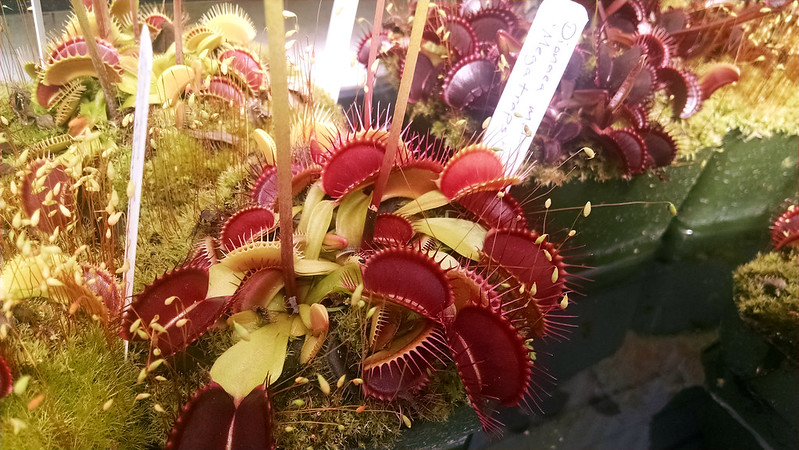 Dionaea muscipula 'Mighty Traps' and a butterwort: 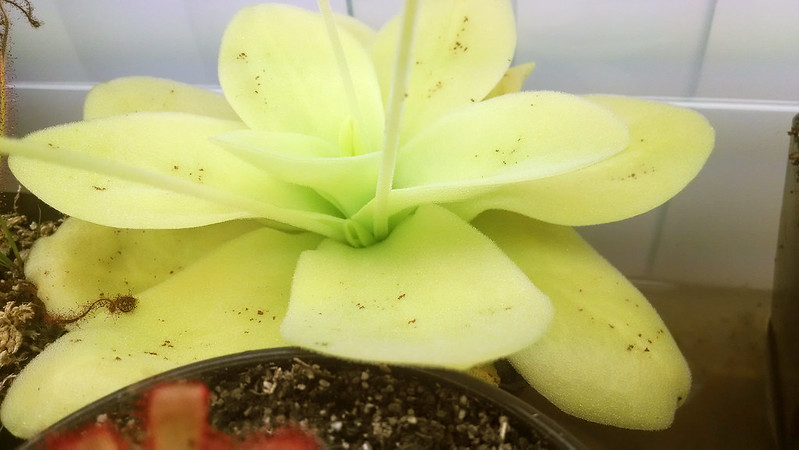 Pinguicula gigantea An unlikely cross, since Pinguicula (butterworts) are more closely related to basil than they are to flytraps. They're great plants though!
|
|
|
|
|
Sounds like it's not that difficult to cultivate them, given you have enough sunlight. Do some of these stink in order to attract insects? Is this a safe hobby? Have you ever been bitten?
|
|
|
|
Sundews (Drosera) Sundews are my favorite carnivorous plants. 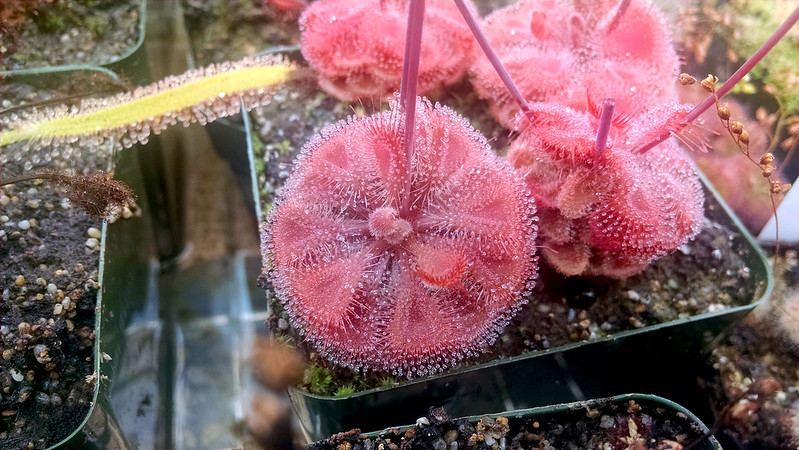 Drosera burmannii from Humpty Doo, Australia. Members of the genus Drosera are some of the most widespread of any carnivores. They're found on every continent except Australia, and are hugely varied, with almost 200 species in the genus. They're found in frozen bogs in Canada, and around seasonal pools in the deserts of Australia. They grow on the tepuis of Venezuela and in the swamps of Texas. They are so cool. 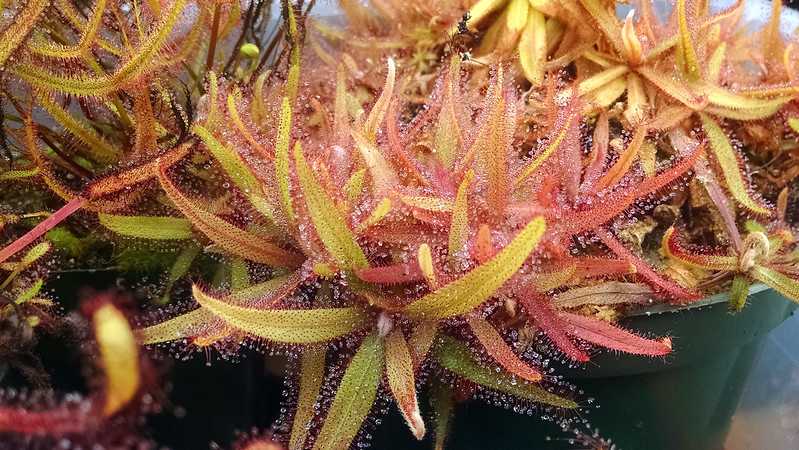 Drosera adelae, from Queensland, Australia. Drosera trap their prey with sticky glands located on tentacles on their leaves. Once the prey is captured the tentacles will fold inward, as will the entire leaf on some species.  Drosera aliciae from South Africa having been recently fed. The Cape Sundew, Drosera capensis, is commonly recommended as a starter carnivorous plant. It was my first plant, and it's still alive (although overgrown) in my collection. Most Drosera are small- to medium-sized plants, which makes them perfect for people who don't have much space. I grow mine under lights, but there are probably sundews that would do fine outdoors in your climate. 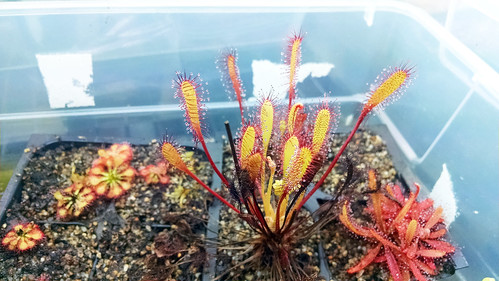 Drosera anglica CA × HI, a cross of two American plants. Sundews are really my wheelhouse, and I can talk about them all day. I do talk about them a lot on my blog, which is called Sundews Etc. Another fantastic website for reading about Drosera is the one that got me into carnivorous plants in a serious way, Grow Sundews.  Drosera burmannii with a victim. Kenning fucked around with this message at 07:04 on Feb 16, 2016 |
|
|
|
lllllllllllllllllll posted:Sounds like it's not that difficult to cultivate them, given you have enough sunlight. Do some of these stink in order to attract insects? Is this a safe hobby? Have you ever been bitten? They're really not that hard to grow. Light intensity is the big bottleneck, and then water quality. I used distilled water for two years before testing my water and realizing the tap would be fine. Lots of people in wetter climates collect rainwater. Once those things are figured out though, it's easy. I fill my trays under the lights whenever they dry out, usually every 7-10 days. The tropical pitchers in my windowsill I water maybe once a week, but if they were to go an extra 3 or 4 days it wouldn't matter. You don't really need to fertilize, and you only repot every several years (and some never get repotted). The main way carnivores attract prey is by simulating flowers. Bright colors and nectar are common (although the sweet-smelling ones are more rare). I don't know of any stinky carnivores. I'll get into the varieties of traps in s later post. As for safety, there's really no danger to us big mammals from these plants. Some tropical pitcher plants produce enzymes that can sting the way pineapple juice stings, but that's about the worst of it.
|
|
|
|
|
I live in an area with very low humidity. Do the plants need it to be humid to do well?
|
|
|
|
What plant is the most vicious looking? And my cats try to eat all plants, are these things very poisonous?
|
|
|
|
can any of them eat cats?
|
|
|
|
Pretty sure pitchers are the actual best attack plants. They can eat froggies! ...I think. Your line about non bug protein now has me worried I fell for a myth. I should totally get some pitchers though. Goatse James Bond fucked around with this message at 01:49 on Feb 3, 2016 |
|
|
Lareine posted:I live in an area with very low humidity. Do the plants need it to be humid to do well? Some plants really need high humidity, but they're in the minority. Plants that do just fine in low humidity: Drosophyllum lusitanicum Sarracenia purpurea Cephalotus follicularis Most Mexican Pinguicula Rosetted Drosera from South Africa and Australia The real killer with low humidity is air disturbance. Because most carnivorous plants are grown in very wet media, often in a tray of water, they will make a slightly more humid environment around themselves. But if it's really dry out and it's windy then they can suffer. D. lusitanicum will grow pretty much anywhere though. It's native to the scrub lands of Portugal, so it's pretty good at low humidity. Darth Freddy posted:What plant is the most vicious looking? One of the most vicious-looking is definitely Nepenthes bicalcarata. 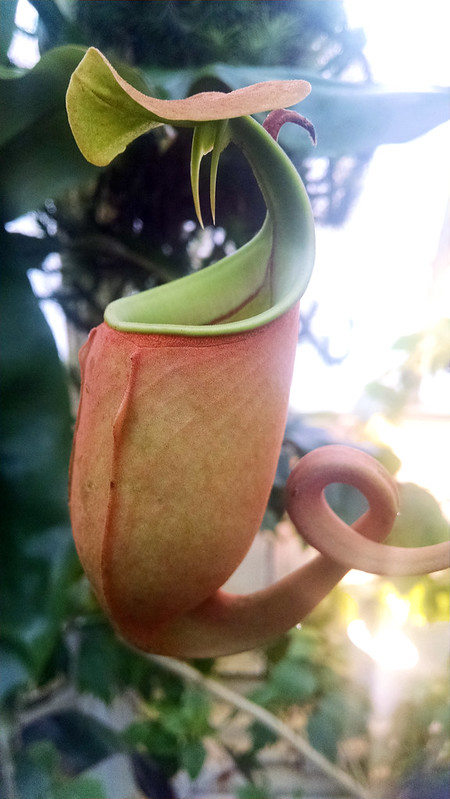 N. bicalcarata Those teeth are supposed to be designed to encourage bugs to venture out and then lose their footing. Nepenthes hamata is the other classic, but I don't have a great picture of it on hand. There are some good ones on the Wikipedia page though. Um, I've often felt that Sarracenia look ominous, in that they are sort of goofy looking, but then you realize that the pitcher tube is buzzing because there are flies inside that are still alive and trying to escape. That's pretty unsettling 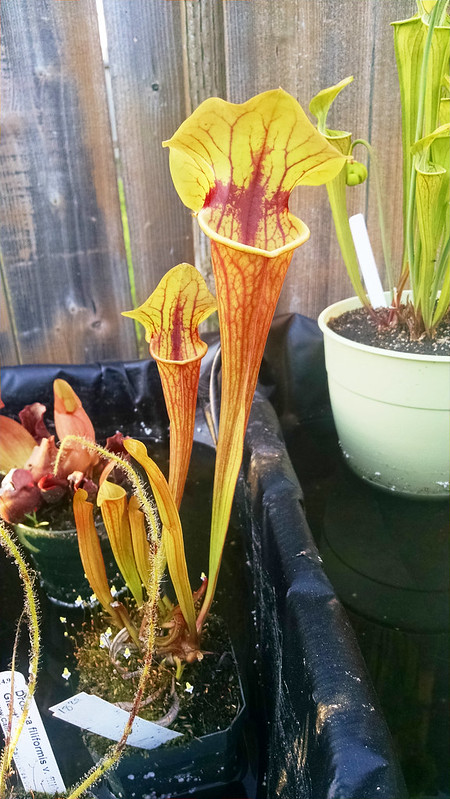 Sarracenia 'Abandoned Hope' As far as I know most carnivorous plants aren't toxic to pets the way that lots of houseplants are. I mean, they probably shouldn't eat them, but it's not like they'll die right away. A bit of nibbling shouldn't be too harmful. Don't quote me on that though: this is not a well-studied part of the hobby. JFairfax posted:can any of them eat cats? Only if you chop up the cat into really small pieces. GreyjoyBastard posted:Pretty sure pitchers are the actual best attack plants. They can eat froggies! ...I think. Your line about non bug protein now has me worried I fell for a myth. Actually, usually the frogs are freeloaders that are just there to steal bugs away from the plants. You see it in greenhouses all the time. Praying mantises do it too. That said, periodically they will catch a small lizard or a particularly stupid frog. Usually that's too much meat in one go though, and the trap will turn black and rot off. It doesn't really hurt the plant, but it's a but much for it.
|
|
|
|
Kenning posted:Venus flytraps aren't the most efficient bug catchers. That honor goes to American pitcher plants. My VFTs outdoors will catch a couple bugs a week though. Is it growing outside? Flytraps are one of the most sunlight-dependent of all the carnivores, and they can really get sluggish in low light. How are you growing yours? It sits on a window sill that gets direct sunlight for most of the day, by a constantly-open window that flies like to hang around.
|
|
|
|
|
Those plants look really cool... I wish they could eat Az Bark Scorpions, I'd be sold on one at that point.
|
|
|
|
How long does it take for them to usually digest something on average?
|
|
|
|
Kenning posted:
So I'm a similar vein, how effective would keeping carnivorous plants indoors be as a bug deterent? We get flies during the summer, enough that it is a nuisance. We only open windows with screens but inevitably a few fly in and like to spend the afternoon flying from my left leg to my right leg and laughing at my swatting attempts. I would love to have a few pitcher plants (if they are the best) or Venus flytraps around the house rather than hang fly paper or something.
|
|
|
|
I once had a sundew in elementary school. It died pretty fast because I had no idea what I was doing, it probably drowned or simply didn't get enough light. Will any of these survive short grey winter days? (assuming a mediocre window and no extra special lighting) I'm around Seattle area and a carnivorous plant would be pretty nifty.
|
|
|
Slavvy posted:It sits on a window sill that gets direct sunlight for most of the day, by a constantly-open window that flies like to hang around. That's funny, it seems like it should get some flies. There was an article in the Carnivorous Plant Newsletter that suggested that VFTs catch more crawling bugs rather than flying bugs though. If you want to own some flies, you should get a sundew. McFunkerson posted:Those plants look really cool... I wish they could eat Az Bark Scorpions, I'd be sold on one at that point. Good luck with your death bugs. blackguy32 posted:How long does it take for them to usually digest something on average? For a flytrap the trap will be closed for about a week and then it will open again, and only the exoskeleton will remain. Drosera vary, but usually about a week as well. American pitcher plants (Sarracenia) are really gross they just develop a column of dead bugs in the pitcher tube at varying stages of digestion. There are gross pictures of this. om nom nom posted:So I'm a similar vein, how effective would keeping carnivorous plants indoors be as a bug deterent? We get flies during the summer, enough that it is a nuisance. We only open windows with screens but inevitably a few fly in and like to spend the afternoon flying from my left leg to my right leg and laughing at my swatting attempts. I would love to have a few pitcher plants (if they are the best) or Venus flytraps around the house rather than hang fly paper or something. This is a super common question, and there are two answers. If you just want pest control, flypaper or poison or whatever else is the best way. Carnivorous plants are native to very marginal habitats, and they have fairly specific needs that need to be met for them to be happy enough to actually catch a bug. If you just buy a sundew or a Sarracenia and stick it in your house just wherever it'll probably die from lack of light, and won't ever have the chance to catch any bugs. That said, I never get houseflies anymore. I use to get them fairly regularly, but now my plants pretty much take care of that. Of course, I have a good-sized collection of plants growing under lights. Your best/cheapest/easiest bet for getting rid of flies would be to get a few Drosera species and a high-output CFL bulb to put in a desk lamp. Try to find like a 300 watt equivalent. Turn the light on when you wake up and off when you go to sleep (or maybe get a cheap timer). That light will cost like $3/mo to run, and the nice thing about using a light is that the flies will naturally be attracted to the light, and then meet their demise. Also the plant will be quite happy if the light is within 6 inches or so of the plant. Lhet posted:I once had a sundew in elementary school. It died pretty fast because I had no idea what I was doing, it probably drowned or simply didn't get enough light. Very unlikely that you drowned it! Sundews (at least the ones most people can get) are bog plants, and are used to growing in absolutely saturated soil. A German researcher recently demonstrated that the traps work even totally submerged. Most likely it died from a combination of high minerals and low light. There are some very good carnivorous plant growers in the PNW. If you get a rosetted species like Drosera aliciae or Drosera spatulata and keep it in the brightest possible windowsill (like, SW exposure if possible) it should do fine. Water it will rainwater or distilled or RO water. As I've said before, Predatory Plants or California Carnivores are probably your best bet if you'd like to grow something indoors. If you're open to pitcher plants, the easier Nepenthes species (N. sanguinea, N. ventricosa, most hybrids) can really thrive in windowsills if your temperatures are mild/cool over all.
|
|
|
|
Kenning posted:That's funny, it seems like it should get some flies. There was an article in the Carnivorous Plant Newsletter that suggested that VFTs catch more crawling bugs rather than flying bugs though. If you want to own some flies, you should get a sundew. Since I posted that he's caught two  Interesting how when the light is a certain way you can see the different parts of the fly being separated and liquified.
|
|
|
|
|
Thanks for the thread and the nice pictures! So those plants evolved to eat bugs to make up for lack of nutrients in the soil. What happens if you put them in the soil that doesn't lack nutrients? Will they grow fewer meat-eating appendages or fewer dew drops? BTW the link to your blog doesn't work.
|
|
|
|
The coloration on those sundews is amazing, but do they have to sit right under fluorescents to get anywhere near where they're at in the picture? The plants lose a lot of their appeal to me if they're stuck in a bulky lighting set up and my town has a fairly dark winter as well
|
|
|
|
Slavvy posted:Since I posted that he's caught two Congrats! And yes, it can get pretty gross. Doctor Malaver posted:Thanks for the thread and the nice pictures! So those plants evolved to eat bugs to make up for lack of nutrients in the soil. What happens if you put them in the soil that doesn't lack nutrients? Will they grow fewer meat-eating appendages or fewer dew drops? If you plant them in nutritious soil they will generally crash and die. It looks a bit like when you over-fertilize other plants. They get weird growth and then look burnt. Some like Nepenthes are more tolerant of soil nutrients, while others like Drosera are very very sensitive to it. Thanks for the heads-up about the blog, SA keeps making it https rather than http, and obviously my blog isn't using https so it just doesn't work. Not sure why it's doing that. Seizon posted:The coloration on those sundews is amazing, but do they have to sit right under fluorescents to get anywhere near where they're at in the picture? The plants lose a lot of their appeal to me if they're stuck in a bulky lighting set up and my town has a fairly dark winter as well Mine sit around 10 inches under my lights. You can get quite good color in sundews without that much light, but there's nothing quite like bright artificial light to make them pop. I'm using around 2700 lumens per sq. ft. of growing area (a fair amount of that is wasted out the sides) and I suspect that that is a bit excessive. Most likely anything above 2000 lumens/sq. ft. would produce very favorable results. You could probably achieve that with a desk lamp and a high-output CFL bulb like some of the 300 watt equivalents from places like 1000bulbs.com.
|
|
|
|
|
American Pitcher Plants (Sarracenia) Sarracenia are probably some of the easiest carnivorous plants to grow. They're the second most popular genus (after Nepenthes), but are definitely much more user-friendly. 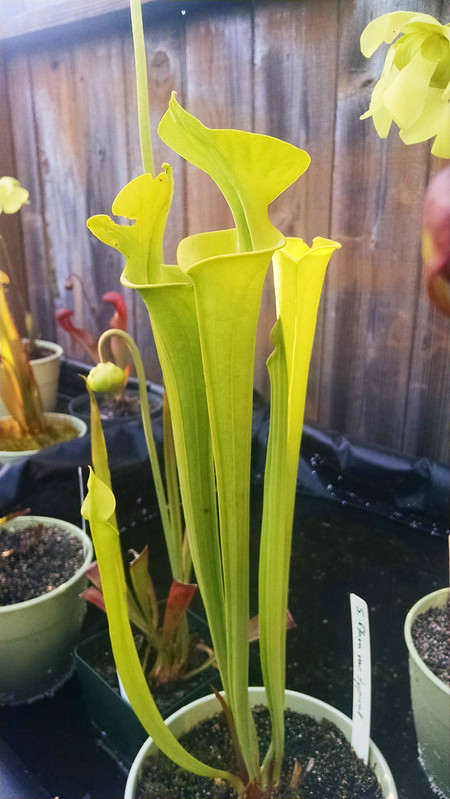 Sarracenia flava, the yellow pitcher plant. I actually lost this plant over the winter and I am pissed about it. Sarrs want full sun, and they do well in backyard planters if you can keep them very wet with some sort of tray. Most are native to the SE United States, but S. purpurea ranges well into Canada. They don't mind freezing temperatures, and if you grow them in in-ground bogs and mulch them well they can even survive extremely cold winters (I know of Sarracenia growers in Niagara). 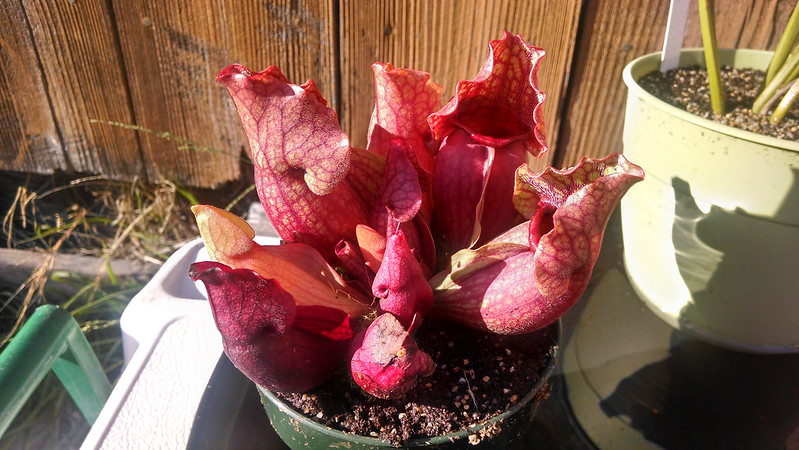 Drosera purpurea, the purple pitcher plant. They grow from rhizomes and go dormant over the winter. Then in spring they produce really weird, alien-looking flowers. This is when the hybrid-crazy collectors do their work people register all sorts of cultivars of Sarracenia hybrids. Some are really great, others are boring. Really though, all Sarracenia are pretty awesome.  Sarracenia alata flowers looking mighty odd. Love them! As I mentioned earlier in the thread, sarrs are the most voracious bug eaters. Old pitchers are often packed with bugs alive, dead, and in varying stages of decay. Sometimes the pitchers will actually topple over because they get too heavy with bugs. It's gross and rad. S. purpurea is probably the ultimate beginner carnivore for people who can grow outside in strong sun, since they are really hard to kill as long as the water isn't too mineral-heavy. Just stick them in the sun and watch them go.  Sarracenia "Deep Throat". I could fit my fist in that pitcher.
|
|
|
|
|

|
| # ? Apr 26, 2024 13:12 |
|
Kenning posted:I could fit my fist in that pitcher. That's what the plant is hoping for. 
|
|
|


